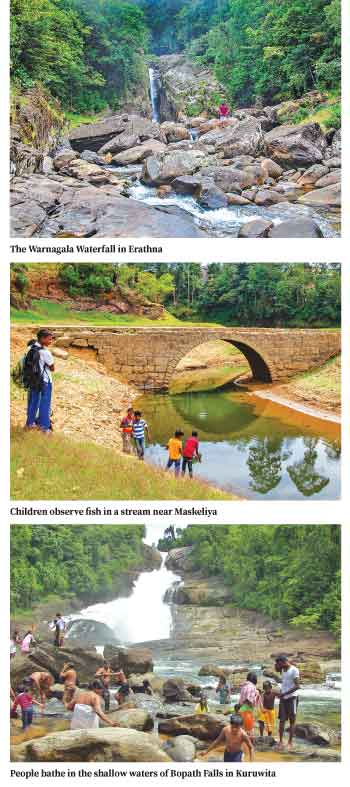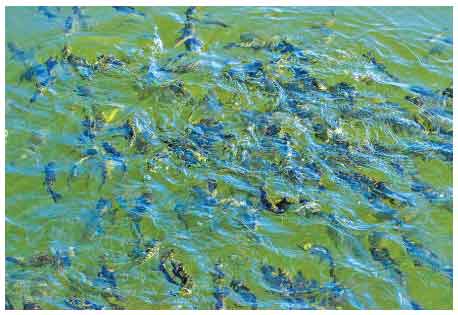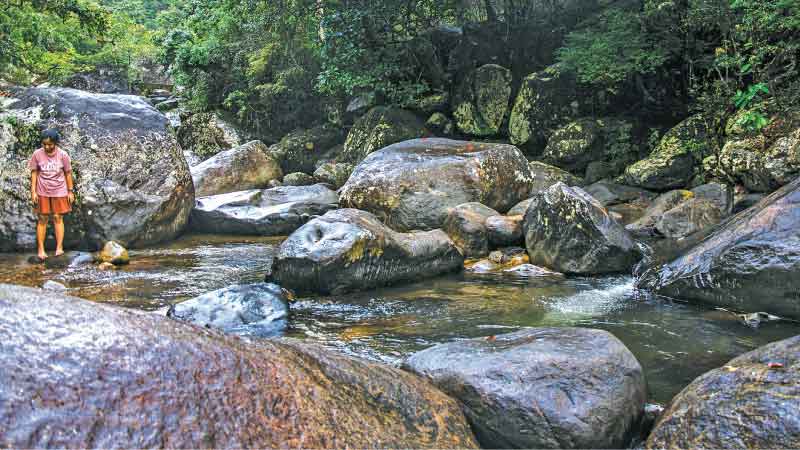 In a country best known for its ocean beaches, permit me to initiate you into the joys of Sri Lanka’s inland waters. There are several places, all within easy reach of major towns, which provide you with many hours of tropical magic.
In a country best known for its ocean beaches, permit me to initiate you into the joys of Sri Lanka’s inland waters. There are several places, all within easy reach of major towns, which provide you with many hours of tropical magic.
Radiating outwards from the central hill ranges into the lower hills, then across the plains and into the island’s many rivers are hundreds of little streams, leading into large ones and eventually into beautiful pools, cascades and a myriad of fascinating vistas to enjoy.
 Of these pristinely lovely spots are such little hamlets as Erathna, Kuruwita, Atweltota, Kitulgala and Belihuloya. And there are dozens more, as yet to be explored with face-mask and flippers, perhaps, an underwater camera.
Of these pristinely lovely spots are such little hamlets as Erathna, Kuruwita, Atweltota, Kitulgala and Belihuloya. And there are dozens more, as yet to be explored with face-mask and flippers, perhaps, an underwater camera.
Since 1935, many of the lovely little fish from these streams have found their way to Western countries. Sri Lanka has maintained a reputation for some fine living gems from these waters. Although they have left us by the thousands, more take their place from breeding in ideal surroundings and almost everywhere you travel to watch fish, you are not disappointed – as long as the waters stay clear and there is no heavy rainfall high up in the mountains.
This is also a gemming country, Ratnapura being the centre of the trade. It is not uncommon for fish watchers to meet gem-seekers of all ages (the older, more grizzled fellows with marvellously photogenic faces seem to have the most experienced eyes of them all) and see how they work. There is nothing frantic or hurried about it. A few words are spoken, and if a gem is found, the potentially lucky one is more than tight-lipped.
If you care to try your hand at amateur gemming. Who knows? You may see a glimmer of blue among the pebbles of these streams, and we all know what that means?
Natural picnic spots
Most of the beauty spots mentioned are easily accessible from the roadside and there are natural picnic spots everywhere. For many reasons, it is safer and wiser to picnic on the rocks and under trees, with water flowing around you. One important reason is ants and leeches. This is, after all, a tropical forest.
Another reason might be to avoid the necessity of washing up, just fling what remains of your sandwiches, biscuits and other luncheon fare into the waters and see the fish swarm around and eat it. By the way he eats, one would imagine that the delicately gold Rasbora vaterifloris has fed on fragments of salami, chicken, apple cores and lettuce all his life, but the fact is that this is new to him – and he loves it.
In only swimming trunks and with a straw hat to keep the sun out, I am the happiest seated waist-deep in gently flowing streams, lunching leisurely and feeding the fish around me. The water is perfectly good to drink, and how nice it is to just duck down and wash up completely.
Among the lovely fish that live here are cuming’s barbs, rugby barbs, fast-swimming giant danios, the furtive cherry barbs in very shallow leaf-filled corners, the slender and ubiquitous blueline rasboras, long-snouted barbs and the striking blacklined barbs.
If you can wedge yourself in a little pool with water rushing around you, look into the maelstrom of bubbles and see the baby mahseer hunt for scraps, the weird stone-sucker getting all he can from the stuff on rocks and maybe a striking spiny eel staring at you perplexedly from under a boulder.
Wherever you look with your mask, there are fish, but to really bring them out – and at close range – crumble some bread in your hands and watch the fragments drift down to eager takers. In many spots near the home of villagers, the fish are tame, trusting and ever-hungry. They have even learnt to like rice and curry.
Rarest birds
Aside from what’s beneath the water, the vegetation up above near these clear streams and pools is breathtaking; the tallest of forest giants, lianas and ferns and parasitic plants in densely packed mattresses of ferns, mosses and lichens and everywhere the hum of insects.

Fish swim in the Budueuwagala tank in Wellawaya
Many of our rarest birds inhabit these jungles as well. With luck and patience, you may spot three-toed kingfishers, the flying jewels of Sri Lanka’s many tree-lined streams. High up in the canopy are Ceylon grackles, their whistling music bright and clear in the mornings.
The yellow-fronted barbet is quite common, especially where any jungle fruit may grow. Here too are the little hanging parrots, usually in the vicinity of bottlefuls of treacle. Layard’s parakeets fly swiftly from their roots or feeding places across small valleys, and perhaps, you will hear the unmistakable cry of the skulking spur-fowl. All of these birds – and most of the fishes as well – are found nowhere else in the world.
Melancholy shadows
Although there’s no really bad season for fish-watching, the best is from mid-December to mid-March. Avoid rainy days, and also remember that evening showers are fairly frequent in these climes. Get to your locations early in the morning and be sure to do all you want to before the sun descends, casting melancholy shadows, and rain filled clouds come in from the higher mountains.









